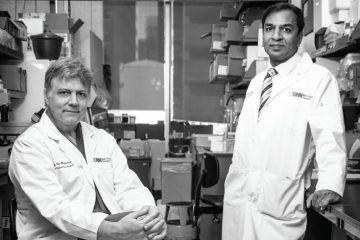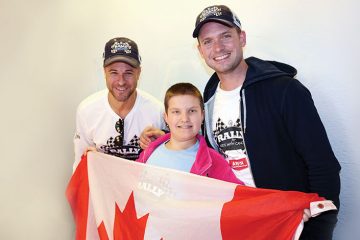Susan Hawkins – Diagnosing Eds
When Susan Hawkins says that things are “happening a little bit too slowly” for her liking, you get the sense that this is a woman who will take control and get things moving.
Seated in a baroque armchair in the lavish living room of her Bridle Path home, Hawkins is discussing the state of research and treatment for Ehler-Danlos Syndrome (EDS), a genetic disorder that robbed her youngest daughter of what were supposed to be the best years of her life. EDS is one of those diseases that doesn’t get much press and isn’t well known. “Certainly we didn’t know about EDS until a year and a half ago,” Hawkins says, acknowledging one of the biggest issues surrounding the disorder: a lack of knowledge and dialogue about a disease that is the bane of so many. This is a problem for Hawkins, and it’s one she is determined to rectify through philanthropic efforts.
Hawkins and her husband, Cecil, owner of Canerector Inc., are regulars on the local philanthropy scene. Known for their much-talked-about fundraising parties, the couple has donated to numerous causes, including helping to fund YWCA Toronto’s Elm Centre, as well as supporting the Pine River Foundation, which offers care and services to youth struggling with mental health and addictive behaviours.
Despite calling Canada’s wealthiest neighbourhood home, Hawkins isn’t one to just write cheques and sit on the sidelines. She served her six-year maximum term on the board of Habitat for Humanity, helping to launch the first Women’s Build event for the Toronto district, which she still participates in to this day, and sits on the executive chair’s advisory committee.
She appreciates the hands-on aspect of the organization, how it gives a hand up not a handout, and how she and other volunteers get to work alongside families to build homes. “I like to go out every year and build houses,” she says. “And just to see their lives change …” She trails off as she remembers the first family they sponsored. They helped build a wheelchair-accessible home for the family’s daughter who had physical challenges. “She still sends me a Christmas card,” Hawkins remarks.
Hawkins’ latest undertaking is far more personal, however. Her daughter Erin Somers, a vibrant 28-year-old with the same golden locks and azure eyes as her mother, suffers from EDS. Somers is welcoming and upbeat, and radiates with an infectious optimism. But her state today is a far cry from 12 months ago. “If you saw her a year ago,” Hawkins says, “she was virtually bedridden. Using a wheelchair to get places. Thin. Just a mess.”
EDS is a genetic disorder that affects collagen in the body’s connective tissue. Connective tissue supports virtually everything in our bodies — skin, muscles, joints, blood vessels, organs — and collagen acts as its glue. Usually collagen bonds are tight and firm, but for those with EDS it becomes fragile. This leads to a multitude of issues that vary in symptoms and severity. It can be as simple as skin that stretches easily or fingers that can be pulled back past being straight. But it can also be far more debilitating, causing chronic pain, frequent bruising, joint dislocation, bone fractures, and the tearing of muscles and rupturing of organs.
Somers has the hypermobility type of EDS, the most common and, as Hawkins notes, “probably the most misdiagnosed.” Somers explains that routine activity often causes intense pain and can lead to dislocations. “It hurts for me to hold a phone and talk on it for more than five minutes,” she says. “And then I need braces on my fingers or else they dislocate when I’m typing or trying to text on the phone.” Two weeks ago she sprained both ankles without even knowing it. Last weekend both her hips went out. Today, it’s her knee.
“Every day something is going to bother me, so it’s just getting through that,” she explains. “And pain makes you very anxious and has different effects on the body, so it’s learning more to deal with the long-term pain rather than just actually the injured site.”
Somers’ symptoms surfaced when she was 12 but became more severe in her early 20s. On top of the pain, she began experiencing gastrointestinal issues and was diagnosed with postural orthostatic tachycardia syndrome, which caused her to faint multiple times a day. She was weak and couldn’t eat solid foods, her weight plummeted to 90 pounds and she was forced to drop out of school. The family took Somers to doctor after doctor, but none could determine the root of the problem. Some went so far as to suggest nothing was wrong or that it was psychological. It became unbearably confusing and frustrating, and Somers even began to doubt herself.
“We went to so many medical appointments,” Hawkins explains. “It’s not like she was misdiagnosed, but there was a missing diagnosis.” Hawkins adds that as a parent the weight of seeing your child suffer is crushing. “You just feel like you’re failing her.”
Somers began doing her own research, reading up on the different disorders that could cause her symptoms. She eventually came across something called Ehlers-Danlos Syndrome. If she had it, there was a possibility that she suffered from cranial instability, a tethered spinal cord and maybe even chiari malformation. It was difficult, however, to convince her doctors. “I was dropped by a GP,” she explains. “He told me it was just an academic diagnosis and it didn’t mean anything for me.” It led to even more frustration and anxiety. “I didn’t really know who I was, and I was so angry.”
Once thought to be a rarity, EDS has gained some notoriety in the media as stories have recently emerged of parents who had their children taken away because it was believed they were physically abusive. Bruises or fractures would be found with no other explanation as to why — until, that is, they got their EDS diagnosis. Because EDS was thought to be so rare, coupled with symptoms that are so widespread, varied and similar to other disorders, doctors may never come across it in their careers, and if they do, they often don’t recognize it.
“One of the problems that we’re having, that we’re trying to address, is how do you actually diagnose it,” says Dr. Allan Gordon, neurologist and director of the Wasser Pain Management Centre at Mount Sinai Hospital and the man who diagnosed Somers with EDS. He explains that there are at least six types of EDS and while some types of EDS have had their genes identified, hypermobility (which Somers has) hasn’t, making diagnosis difficult. “There’s no gold standard yet for diagnosis,” says Dr. Gordon, adding that it’s possible there may be more than one gene involved.
“There may be, we don’t know.”
According to the Ehlers-Danlos National Foundation, EDS could affect between 1 in 2,500 and 1 in 5,000 people. But because it’s so difficult to identify, those numbers could be even higher.
Diagnosis is made more difficult because of how doctors are taught to make medical evaluations. During training, medical interns are told, “When you hear hoofbeats, think of horses not zebras,” as in “Don’t make an exotic diagnosis when the most common answer is likely the right one.” It’s sensible advice, words that help keep medical practitioners grounded and looking for the most logical cause of suffering. But in those rare instances when the zebra is actually present, patients can be left in the dark.
These are key motivators behind Hawkins and Somers’ endeavour. Through the Improving Lives of Children Foundation, of which Hawkins is a director, the mother and daughter team threw their first garden party this past June to generate awareness and raise money for an upcoming conference this November, where doctors from the United States and Canada can fill gaps in knowledge of this complex disease. Held at Hawkins’ Bridle Path home, the zebra-themed fundraiser brought together 170 black-and-white-clad guests and the elegant evening raised $160,000.
“I thought it was a typical Susan Hawkins event: fantastic, well done, raised a lot of money and everybody had fun,” says Robert Herjavec, the event’s emcee. The Shark Tank star has known the Hawkinses for years; it’s been heartbreaking to watch them endure this disease. He explains that when Hawkins supports something she does so 100 per cent. “Whether it’s this cause or Habitat for Humanity, she doesn’t do it just to put on a show. She does it because she really believes in the event. It’s very admirable.”
The big reason for Somers’ dramatic turnaround was two surgeries she had last summer to fuse her spinal cord. It brought stability to her spinal column and has mitigated much of the pain. She’s gained some independence, has returned to university, exercises and can have at least a somewhat normal life with her husband, who she married last year. “It made me believe in myself a lot more when I got better,” Somers says. “I think that was one of the biggest things for me, just trying to get back onto my own team.”
Hawkins knows that her family is lucky. The surgeries, for one, were performed by a specialist in Maryland in the United States and resulted after a rotational CT scan and stand-up MRI, technology mostly unavailable in Canada. Getting such treatment is expensive and more than likely out of reach for many. “We can afford to pay for Erin’s surgeries, and we’re happy to do that, but no one has been successful in getting OHIP to pay for it,” she says. Hawkins also knows it’s not a cure-all and Somers may need more surgeries down the road. It also won’t be successful for every EDS patient. “It’s not the be-all and end-all,” she adds. “She had so much instability in her spinal column that she had great results from the surgery.”
Dr. Gordon explains that EDS patients don’t always do well with surgical interventions and such surgery can be risky and lead to complications. “We’re trying to promote a cautionary approach to treating these patients,” he says, adding that more published research and studies are needed for doctors to make better judgments.
Hawkins, who is also the vice-chair of the Ehlers-Danlos National Foundation, wants to get those papers published to help doctors understand the benefits. She’s also determined to fund research to identify the hypermobility gene, noting, “I think that if we had a simple genetic test, it would be easier for doctors to diagnose that.” She’s also hoping that the conference this November will generate much-needed discussion. “My hope is that we’ll have a lot more doctors out there who are talking about EDS, diagnosing EDS.
“There are answers out there. We just have to learn more and we’ve got to educate our doctors.”
With more research and dialogue, things can get moving. And maybe a little faster than they were before.
www.ednf.org






















































































No Comment